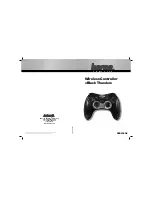
CHAPTER 2: QUICK START
SNAP PAC S-Series User’s Guide
31
31
About the Controller’s Memory Map
Like SNAP Ethernet-based brains, a SNAP PAC S-series controller uses a memory mapped system for
storing data and making that data available to other devices on the Ethernet network. This data
includes configuration data, status information about the controller itself, and PAC Control strategy
variable data that may be needed by a peer on the network.
Although SNAP PAC S-series controllers are designed to run PAC Control strategies, you can also
write your own software applications to communicate with the controller’s memory map, either
instead of or in addition to using PAC Control. You can use the OptoMMP Communication Toolkit or
the IEEE 1394-based protocol for writing your applications. Both are explained in Opto 22 form 1465,
the
OptoMMP Protocol Guide
, which also includes complete details of the memory map. Although
this guide is written for I/O units, you can use the same information for a SNAP PAC S-series
controller. Just be aware that many sections do not apply, since the controller’s memory map doesn’t
include any I/O point or related information.
The SNAP PAC S-series controller’s memory map includes only the following areas:
Using Data for Peer-to-Peer Communication
Scratch Pad areas within the SNAP PAC S-series controller’s memory map provide a way for other
devices on the Ethernet network to access data in the controller. For descriptions of the Scratch Pad
areas—bits, integers, floats, and strings—see the
PAC Manager User’s Guide
. For help in using PAC
Control commands to access Scratch Pad areas, see “I/O Unit—Scratch Pad Commands” in Chapter
10 of the
PAC Control User’s Guide
.
If you are not using PAC Control but writing your own software applications to access the Scratch Pad
areas, see the
OptoMMP Protocol Guide
. This guide is written primarily for I/O units, but much of the
same information on programming applies to SNAP PAC S-series controllers. The Scratch Pad areas
of the memory map are described in the programming guide’s appendix.
If you’re communicating between an Allen-Bradley Logix-based PLC and an S-series PAC, see the
EtherNet/IP for SNAP PAC Protocol Guide
.
Status Area Read
Communications Port Configuration
Date and Time Configuration
Status Area Write
Security Configuration
Scratch Pad
PPP Configuration
PPP Status
microSC Card
IP Settings
WLAN Configuration
WLAN Status
Содержание SNAP-PAC-S1
Страница 6: ...SNAP PAC S Series User s Guide vi...
Страница 32: ...INSTALLING AND CONFIGURING THE CONTROLLER SNAP PAC S Series User s Guide 26 SNAP PAC S1 W Antenna Dimensions...
Страница 34: ...INSTALLING AND CONFIGURING THE CONTROLLER SNAP PAC S Series User s Guide 28 SNAP PAC S2 W Antenna Dimensions...
Страница 64: ...CONFIGURING PPP SUPPORT IN MICROSOFT WINDOWS SNAP PAC S Series User s Guide 58 General Tab Options Tab...
Страница 65: ...APPENDIX B PPP SUPPORT IN MICROSOFT WINDOWS SNAP PAC S Series User s Guide 59 59 Security Tab Networking Tab...
Страница 68: ...CONFIGURING PPP SUPPORT IN MICROSOFT WINDOWS SNAP PAC S Series User s Guide 62 Options Tab Security Tab...
Страница 69: ...APPENDIX B PPP SUPPORT IN MICROSOFT WINDOWS SNAP PAC S Series User s Guide 63 63 Networking Tab Sharing Tab...
Страница 78: ...SNAP PAC S Series User s Guide 72...
















































